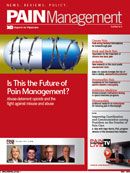Publication
Article
Pain Management
A Chilling Effect
Publisher's note, December 2011.
In 2011, there were many promising developments in pain management, including exciting new research in pain pathways, assessment, and treatment; new drug approvals that give physicians and patients more options when devising pain management plans; movement on the REMS front; and approval of prescription drug monitoring programs by several states. These are just a few of the advances and positive developments that bode well for physicians and patients in the years to come. However, we also learned more about several troubling trends in pain management this year, none more sobering than the mounting evidence of the scope and severity of the problem of misuse, abuse, and diversion of prescription pain medications in this country. The CDC’s recently released report on this topic (http://1.usa.gov/tRklfE) tells a grim tale: 15,000 deaths from prescription painkiller overdose in 2008, 12 million Americans age 12 and older reported using prescription pain medications for nonmedical purposes in 2010, half a million emergency department visits in 2009 due to misuse and abuse of prescription pain drugs, and the proliferation of “pill mills.” The danger to the public health represented by these numbers is very real, and it merits all the effort and attention that have been devoted to finding solutions that increase public safety while preserving access to needed medications. However, there is another side of the story that carries grave risks for patients and providers that I wish would get more attention than it currently does.
Fear of scrutiny from state medical boards and investigation by the DEA and other law enforcement agencies leads too many primary care physicians to refer patients with chronic pain to a pain specialist rather than treating them themselves. Given the current uncertain and fraught legal and regulatory environment, it is in some ways understandable that many primary care physicians, already chronically overburdened and under-reimbursed, would elect not to expose themselves and their practices to the increased risks associated with providing pain care.
But what happens to patients with legitimate medical needs who live in underserved and rural areas with no ready access to pain specialists? What happens to patients who live in a city or town in which there are few options for accessing practitioners who specialize in the medical management of chronic pain? Many patients in these situations are forced to wait weeks (or even months) to see a specialist. In the mean time, they are forced to choose between searching for the increasingly rare primary care practitioner who will take on new chronic pain patients who are already being treated with opioids and going without prescription medications until they can secure an appointment with a prescribing physician. Unfortunately, many patients opt to pursue a third option: turning to friends, family, or the Internet in order to obtain medications.
This is what happens when seemingly arbitrary enforcement of frequently vague and confusing rules and guidelines can result in severe penalties for practitioners. The lack of clear standards and predictable triggers of investigations have combined to put a chill on legitimate pain management for too many patients. Physicians should not be asked to practice within a professional context that on the one hand insists they serve the patient’s medical needs above all and on the other threatens them with criminal and financial penalties for violating ill-defined standards of treatment (about which there is often substantial professional disagreement on proper procedure) or for failing to identify and police patients who may be engaging in suspicious and possibly illegal behavior. And patients with legitimate pain care needs should not be forced to seek treatment within a system that treats them as if they were drug-seeking addicts, conspires to restrict their options when it comes to selecting a provider, and promotes an atmosphere of distrust between them and their physicians.
